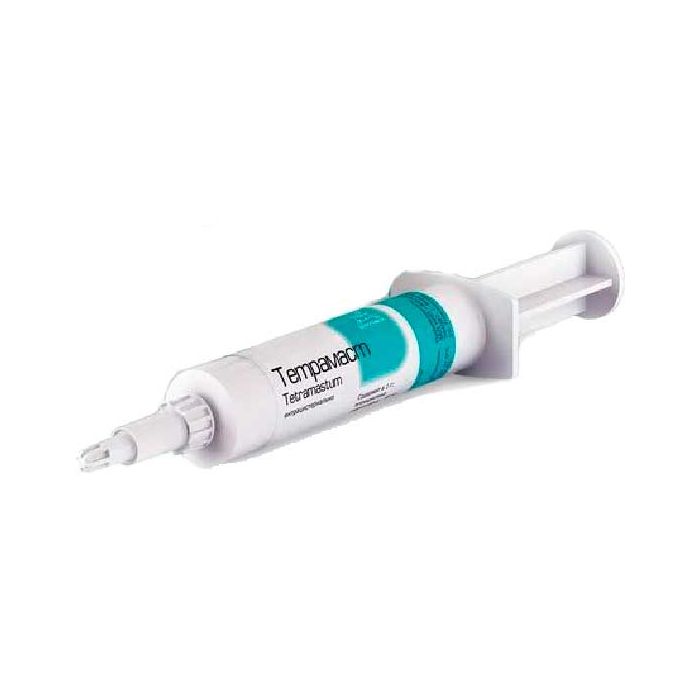Tetramast syringe-tube 10ml
DESCRIPTION
Tetramast is used to treat mastitis in lactating cows.
COMPOSITION
1.0 ml contains 35 mg of tetracycline hydrochloride as an active ingredient, as well as auxiliary substances: 43.75 mg of beeswax or beeswax, 1.05 mg of magnesium oxide and vaseline oil - up to 1 ml.
PHARMACOLOGICAL PROPERTIES
Pharmacological group: antibiotics.
Tetracycline is active against gram-positive microorganisms: Staphylococcus spp. (including Staphylococcus aureus, including strains producing penicillinase), Streptococcus spp. (including Streptococcus pneumoniae), Listeria spp., Bacillus anthracis, Clostridium spp., Actinomyces israelii; gram-negative microorganisms: Haemophilus influenzae, Haemophilus ducreyi, Bordetella pertussis, most enterobacteria: Escherichia coli, Enterobacter spp., including Enterobacter aerogenes, Klebsiella spp., Salmonella Vibonella spp., Shigella spp., Yersinella spp., Shigella spp., Yersinella bacterium fetus, Rickettsia spp., Borrelia burgdorferi.
The mechanism of the bacteriostatic action of tetracycline is due to a violation of the formation of a complex between the transport RNA and the ribosome, which leads to the suppression of protein synthesis in the microbial cell and its death.
With intracisternal administration of the drug, tetracycline is slightly absorbed into the bloodstream and has mainly an antibacterial effect in the parenchyma of the mammary gland. Tetracycline is excreted from the body of the animal in an unchanged form, mainly with milk and, to a small extent, with urine.
According to GOST 12.1.007-76, Tetramast belongs to low-hazard substances (hazard class 4). When administered intracisternally into the mammary gland of clinically healthy lactating cows, the drug causes a slight, rapidly passing irritation of the udder tissues.
DOSAGE AND APPLICATION
Tetramast is administered intracisternally: for subclinical, serous and catarrhal mastitis, 5 ml once a day for 3-4 days; with purulent-catarrhal mastitis - the first injection of 10 ml, then 5 ml at intervals of 24 hours for 5-8 days.
Before the introduction of the drug from the diseased quarter of the udder, the secret is milked out, and the nipple is disinfected with 70% ethyl alcohol.
Before use, Tetramast is heated to 36-39 В° C and shaken. The drug is collected from the vial with a sterile syringe and injected into the nipple of the affected quarter of the udder using a catheter. When using a syringe-dispenser, its cannula is tightly pressed against the opening of the nipple canal and the drug is injected. After the introduction, a light massage of the udder is carried out from the bottom up.
Before the introduction of the second dose of the drug remaining in the syringe-dispenser, the cannula of the syringe-dispenser is treated with 70% ethyl alcohol.
SPECIAL INSTRUCTIONS
The peculiarities of the action of the drug during its first use and withdrawal have not been established.
Skipping the next dose of the drug should be avoided, as this can lead to a decrease in its therapeutic efficacy. If one dose is missed, the use of the drug is resumed in the same dosage and according to the same scheme.
Slaughter of cows for meat is allowed no earlier than 5 days after the last injection of the drug.
The meat of animals that were forcedly killed before the expiration of the specified period can be used as feed for fur animals.
For food purposes, milk is used no earlier than 7 days after the last administration of Tetramast, provided that the signs of mastitis, confirmed by mastitis tests, disappear completely.
During treatment and within 7 days after the last use of the drug, milk from the affected quarters is disposed of, and from the rest, it is used after boiling into animal feed.
CONTRAINDICATIONS
Contraindication to the use of the drug is the increased individual sensitivity of the animal to tetracyclines.
It is forbidden to use Tetramast simultaneously with aminoglycosides, penicillins, cephalosporins due to the fact that tetracycline reduces their bactericidal activity.
SIDE EFFECTS
When using Tetramast in accordance with this instruction, side effects and complications in cows, as a rule, are not observed. In the event of allergic reactions, the use of the drug is discontinued and antihistamines and symptomatic agents are prescribed to the animal.
When administered intracisternally into the mammary gland of clinically healthy lactating cows, the drug causes a slight, rapidly passing irritation of the udder tissues.
SHELF LIFE AND STORAGE
Tetramast is stored in a closed manufacturer's packaging in a dry, dark place, separate from food and feed, at a temperature of 5 В° C to 20 В° C.
The shelf life of the medicinal product, subject to storage conditions, is 1.5 years from the date of manufacture.
PACKAGING
Syringe tube 10 ml.
Specifications
KolVUP
20
Manufacturer
AgroFarm
Temperature regime
from +5 to +25
Teaser
antibiotic for the treatment of mastitis in cows

